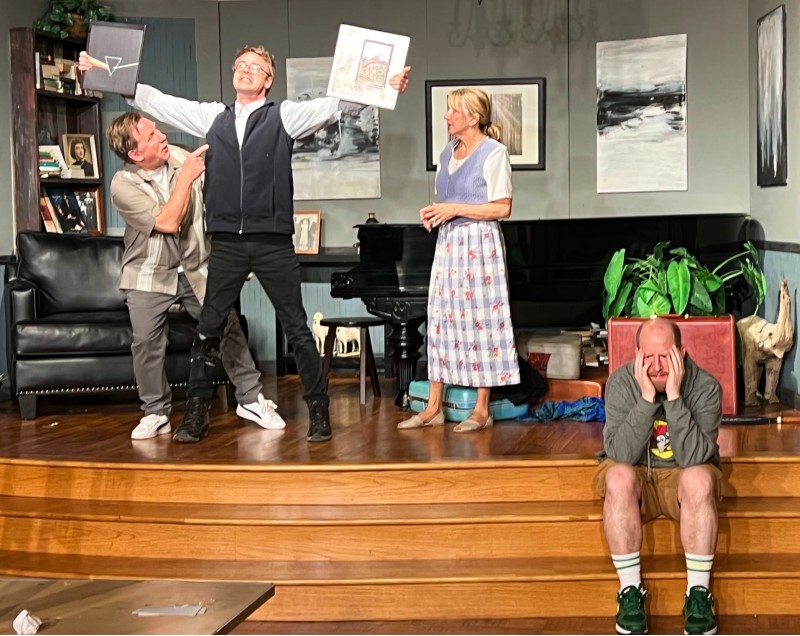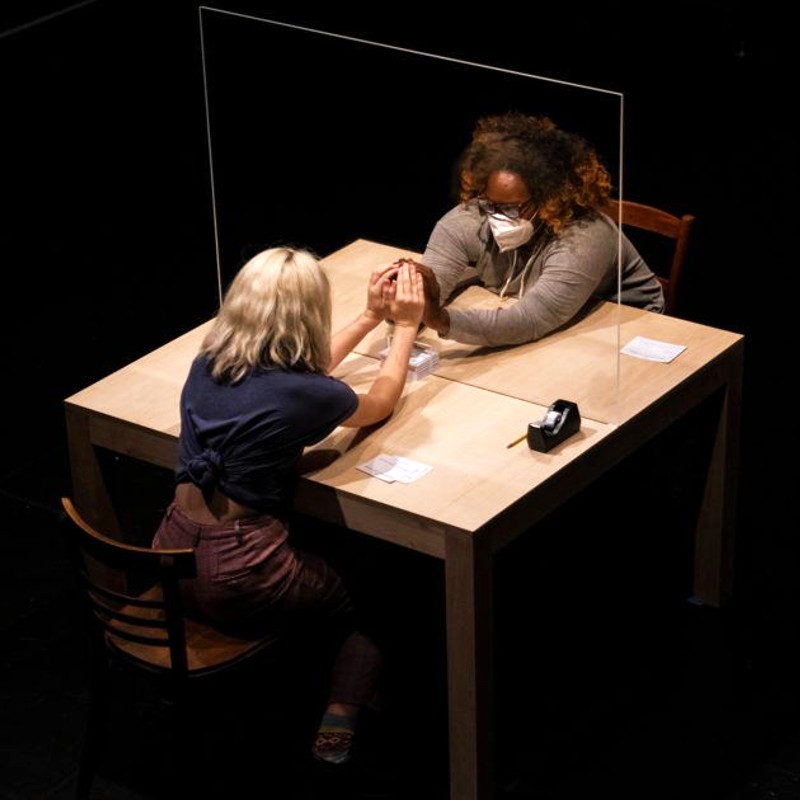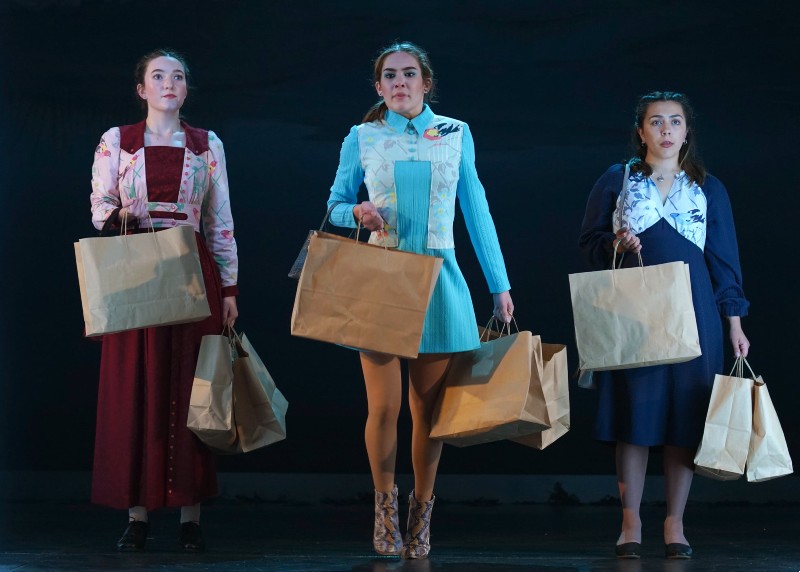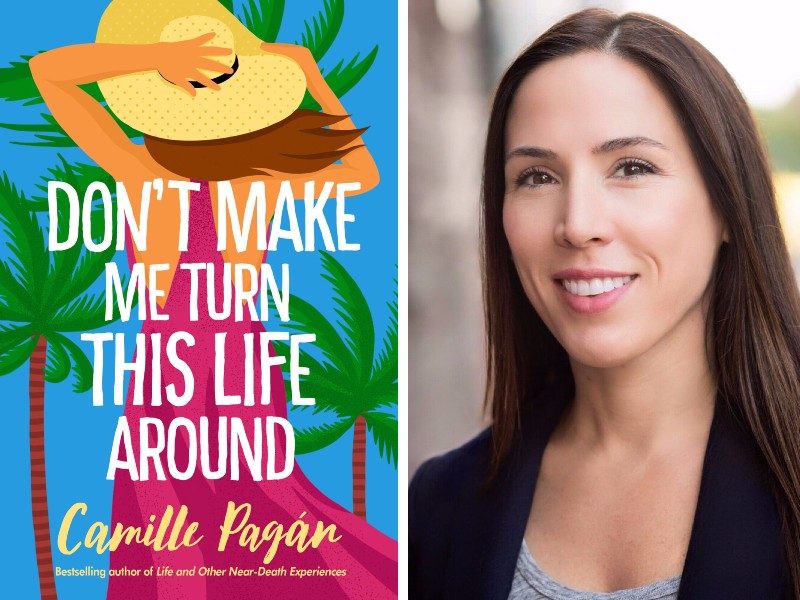Antoinette Chinonye Nwandu’s “Pass Over” is a Black Lives Matter-era translation of Exodus and "Waiting for Godot"

The time is ripe for Antoinette Chinonye Nwandu’s Pass Over, now on stage at Theatre Nova.
The play was the show that officially reopened Broadway last August; we’re fast approaching the holiday of the same name, which commemorates the Jews’ emancipation from slavery in Egypt; and given the reignited culture wars of this mid-term election year—fueled in part by debate about critical race theory—Nwandu’s powerful reimagining of Beckett’s Waiting for Godot, with two young Black men in the lead roles, feels like the theatrical version of lightning in a bottle.
Pass Over (run time 80 minutes) focuses Moses (Justin Montgomery) and Kitch (Dan Johnson), who live a hardscrabble Groundhog Day-like existence on a heavily policed city block. They regularly perform rituals like a secret handshake; Moses says “Kill me now” when he wakes up each morning, and Kitch replies, “Bang bang”; and they each name wished-for items on their “Promised Land Top Ten” lists.
But even as the men speak and dream of escape—using language so rife with curses and the n-word that it soon feels more centered on sound and music than meaning—they’re not going anywhere; and a streetlight pole that looms like Vladimir and Estragon’s tree, in this new context, haunts the play’s action with the ominous suggestion of lynching. Building on this idea, a cartoonishly obsequious, lost, “golly gee” white man (Kevin O’Callaghan) enters the scene, wearing a light-colored suit and carrying a picnic basket full of food for his mother; and a racist, violent white cop called Ossifer (also played by O’Callaghan) appears now and then to keep Moses and Kitch in their place, both literally and figuratively.
Penny Seats Theatre Company's "The Actors" is a comedic and emotional look at processing parental loss

Early in Ronnie Larsen’s play The Actors—staged by the Penny Seats Theatre Company at the Stone Chalet Event Center in Ann Arbor—a character says, “Theater’s weird. Families are weird.”
Ronnie, the comedic drama’s main character (who notably shares the playwright’s name, and is affectingly played by Brandy Joe Plambeck), voices this idea while explaining why he’s looking to hire a man and a woman to spend a few hours a week in his apartment, playing the roles of his deceased parents. He's lonely and has decided to use his inheritance money to hire actors that might make him feel cared for and connected again. Ronnie provides a family history and specific, remembered scenes for the actors to play out, inviting them to improvise.
Inevitably, though, things go hilariously off-the-rails, as the boundaries between reality and pretend get increasingly fuzzy. Ronnie’s stand-in father Clarence (Robert Schorr) and mother Jean (Diane Hill) develop an attraction for each other; Clarence moves in, after being kicked out of his real home; and Jean’s real grown son (David Collins) inserts himself as Ronnie’s pretend older brother Jay, which makes the real Jay’s (Jeffrey Miller) unannounced visit all the more painfully awkward. But Jay’s arrival also brings new information to light that throws Ronnie’s family memories, and motives, into question.
Touching From a Distance: “A Thousand Ways (Part 2): An Encounter” explores emotional connections between strangers

After months of isolation and “Zoom socializing,” many of us are probably feeling pretty rusty when it comes to face-to-face conversations with strangers—which seems a raison d’etre of 600 Highwaymen’s A Thousand Ways (Part 2): An Encounter, presented by the Ann Arbor Summer Festival and the University of Michigan Museum of Art.
This intimate, interactive theater experience positions you and a stranger across from each other at a table, with a glass partition between you, in an empty room at UMMA. You take turns reading from a stack of cards—a black arrow indicates which of you the card is for—and you read aloud from it, or follow instructions like, “Imagine what keeps this person up at night,” or “wink with each eye,” or “with your partner, make a box with your hands against the glass.”
This Woman's Work: UMSTMD's "Nora" explores Ibsen's "A Doll's House" through three different eras

I felt guilty for stealing away, by myself, for a few hours on Sunday to see U-M’s Department of Theatre and Drama production of Stef Smith’s Nora: A Doll’s House, leaving my kids and spouse to fend for themselves.
Fittingly, this discomfort points to Nora’s raison d’être: no matter how much we want to believe otherwise, a woman’s role in the domestic sphere really hasn’t changed that much over the past century.
Using Henrik Ibsen’s classic 1879 play, A Doll’s House, as a blueprint, Smith retells the story of Nora—who scrambles to keep secret her method of keeping the family afloat during her husband’s past illness—as she would appear in three different time periods: 1918, 1968, and 2018.
Theatre Nova's "The Lifespan of a Fact" is a compelling issue play built on a lopsided debate

During a set change in Theatre Nova’s first live, in-person production in front of an audience since March 2020, a stage crew duo flipped and turned an office desk to reveal a fluffy couch.
As this metamorphosis played out on the Yellow Barn’s stage Saturday night, the audience—masked and seated in spread-out chairs—ooooh-ed and gasped in delighted surprise.
I’m clearly not the only one who’s been pining for little hits of theater magic during this pandemic.
Review: Ann Arbor Summer Festival’s “A Thousand Ways (Part One): A Phone Call”

By sheer coincidence, I experienced the Ann Arbor Summer Festival’s theatrical presentation of A Thousand Ways (Part One): A Phone Call at a time when I’d also revisited Mandy Len Catron’s viral essay, “To Fall in Love with Anyone, Do This,” which references 36 questions purported to accelerate intimacy between two strangers.
What’s the connection, you ask?
A Thousand Ways (created by Brooklyn-based troupe 600 Highwaymen) is a phone conversation between you and a stranger, moderated by a pre-recorded, Siri-like voice that poses questions, offers pieces of an imagined narrative, and issues orders. By the end of the hour-long call—filled with seemingly innocuous queries that nonetheless revealed a great deal about ourselves—I felt strangely connected to, and emotionally invested in, the other participant.
To the point that I felt a little heartbroken when I realized that neither of us had enough information to find each other later in real life.
And I felt this sadness despite the fact that we never exchanged names or laid eyes on each other (the latter was part of psychologist Arthur Aron’s experiment, which gave rise to the infamous 36 questions).
The impact struck me as especially curious in this moment, when we’re all slowly emerging from our respective pandemic hidey-holes. We’ve been able to talk by phone with each other this whole time; it was, indeed, one of the safest means of socializing. So why did a pre-recorded moderator make it a far more meaningful, memorable phone conversation than most I had with friends and family during quarantine?
Camille Pagán's "Don’t Make Me Turn This Life Around" was partly inspired by the Ann Arbor author's disastrous vacation

During this cloistered pandemic year, lots of us have daydreamed about escaping to sunny, tropical destinations.
So readers drawn to the beach-y cover of Ann Arbor-based novelist Camille Pagán's latest release, Don’t Make Me Turn This Life Around, may be initially surprised to find that the book tells the story of a family getaway to Puerto Rico that goes very, very wrong.
But let’s keep in mind the time in which it was born.
“It’s my pandemic book,” says Pagán, and it follows up on the characters from her Amazon bestseller Life and Other Near Death Experiences but can also stand on its own. “It took me a while to get excited about it. … But I knew I wasn’t done with Libby. She’s my favorite of any of the characters I’ve created.”
Theatre Nova’s Zoom play series continues with "Mortal Fools" by Ann Arbor playwright Catherine Zudak

The Goldilocks Principle, though not regularly cited in reference to storytelling, can nonetheless be maddening for those who build narratives.
For how does a writer determine, in each scene, what’s too much information (thus bogging things down and killing suspense) and what’s too little (leaving audiences confused and frustrated)? How do you consistently land upon what feels “just right”?
It’s a notoriously tough needle to thread—particularly within the tight parameters of a 30-minute Zoom play—and this notion was something I thought about often while watching the third and newest entry in Theatre Nova’s Play of the Month series, Mortal Fools, by Ann Arbor-based playwright Catherine Zudak. (The live performance recording of Fools may be viewed—along with the first two entries in Theatre Nova’s Zoom play series, Jacquelyn Priskorn’s Whatcha Doin? and Ron Riekki’s 4 Genres—with the purchase of a $30 series pass, which also covers admission for the fourth and final play in the series, Morgan Breon’s The W.I.T.C.H., scheduled to be performed April 28 at 8 pm)
From the Fifth Estate to Ann Arbor: Harvey Ovshinsky's new memoir recalls his agitating and publishing days in Detroit

Ann Arbor’s Harvey Ovshinsky faced a problem when he settled in to write his memoir, Scratching the Surface: Adventures in Storytelling.
“I sat down with Kathryn [Wildfong] at Wayne State University Press, and she said, ‘Oh, my God, Harvey, there are three or four different books in here. You’ve got to pick one,’” Ovshinsky said. “I have all these dots and I really felt the need to connect them, and I knew I could. … What they all had in common was my need to scratch the surface. And that’s when [the book] came together.”
The book's focus was originally a puzzle to solve because Ovshinsky is a lifelong restless spirit.
Ann Arbor native David Blixt discovered a cache of long lost novels by journalist-adventurer Nellie Bly

In December 2019, while researching a novel series based on the life of journalist Nellie Bly, Ann Arbor native David Blixt—a Greenhills and EMU grad who’s now a Chicago-based theater artist and writer—made an astonishing discovery.
“At that point, my office was right next to the kitchen, and Jan [Blixt, David’s wife, and the producing artistic director of the Michigan Shakespeare Festival] was in the kitchen late in the afternoon that day,” said Blixt. “I was going, ‘Honey, this can’t be real. This can’t possibly be real. … Surely everybody knows about this, right?’”
Wrong. Blixt, following what seemed an unlikely-but-possible hunch, had stumbled upon 12 long-lost serialized novels that Bly wrote after her famous trip around the world concluded in 1890.
Born Elizabeth Cochrane in 1864 in Pittsburgh, Bly got her pseudonym from her first newspaper editor, who named her after a popular 1850 song by Stephen Foster. Scholars and biographers have long known that Bly wrote fiction for publisher Norman Munro’s New York Family Story Paper—she’d signed a lucrative, three year $40,000 contract—but few to no copies of that publication have survived, so Bly’s fiction has largely been lost to time for well over a century.
Until now.


































